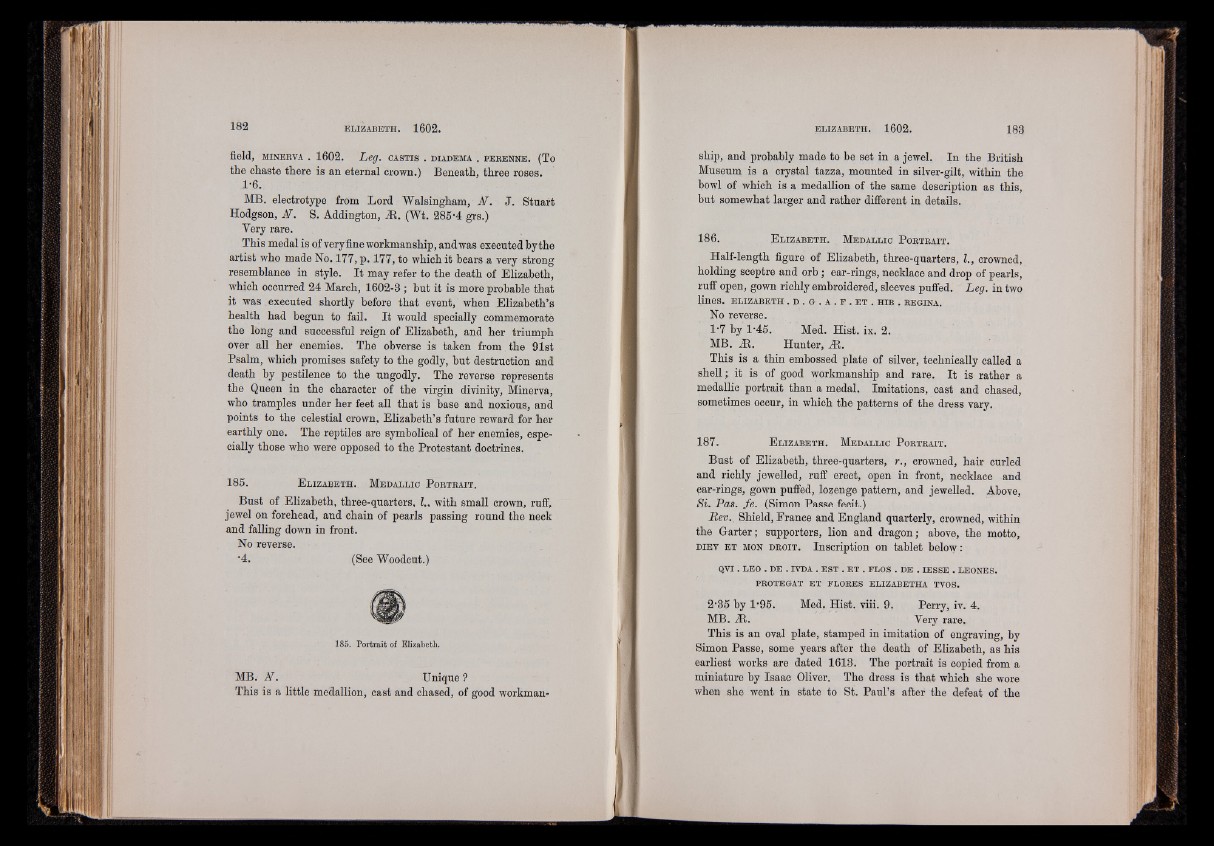
field, m in e r v a . 1602. Leg. c a s t i s . d i a d em a . p e r e n n e . (T o
the chaste there is an eternal crown.) Beneath, three roses.
1-6.
MB. electrotype from Lord Walsingham, N . J. Stuart
Hodgson, N . S. Addington, At. (Wt. 285-4 grs.)
Very rare.
This medal is of very fine workmanship, and was executed by the
artist who made No. 177, p. 177, to which it bears a very strong
resemblance in style. I t may refer to the death of Elizabeth,
which occurred 24 March, 1602-8 ; hut it is more probable that
it was executed shortly before that event, when Elizabeth’s
health had begun to fail. It would specially commemorate
the long and successful reign of Elizabeth, and her triumph
over all her enemies. The obverse is taken from the 91st
Psalm, which promises safety to the godly, hut destruction and
death by pestilence to the ungodly. The reverse represents
the Queen in the character of the virgin divinity, Minerva,
who tramples under her feet all that is base and noxious, and
points to the celestial crown, Elizabeth’s future reward for her
earthly one. The reptiles are symbolical of her enemies, especially
those who were opposed to the Protestant doctrines.
185. E l i z a b e t h . M e d a l l i c P o r t r a i t .
Bust of Elizabeth, three-quarters, I., with small crown, ruff,
jewel on forehead, and chain of pearls passing round the neck
and falling down in front.
No reverse.
'4. (See Woodcut.)
185. Portrait of Elizabeth.
MB. N . Unique ?
This is a little medallion, cast and chased, of good workmanship,
and probably made to be set in a jewel. In the British
Museum is a crystal tazza, mounted in silver-gilt, within the
bowl of which is a medallion of the same description as this,
but somewhat larger and rather different in details.
186. E l i z a b e t h . M e d a l l i c P o r t r a i t .
Half-length figure of Elizabeth, three-quarters, I., crowned,
holding sceptre and orb ; ear-rings, necklace and drop of pearls,
ruff open, gown richly embroidered, sleeves puffed. Leg. in two
lines. ELIZABETH . D . G . A . F . ET . HIB . REGINA.
No reverse.
1'7 by 1-45. Med. Hist. ix. 2.
MB. At. Hunter, JR.
This is a thin embossed plate of silver, technically called a
shell; it is of good workmanship and rare. It is rather a
medallic portrait than a medal. Imitations, cast and chased,
sometimes occur, in which the patterns of the dress vary.
187. E l i z a b e t h . M e d a l l i c P o r t r a i t .
Bust of Elizabeth, three-quarters, r., crowned, hair curled
and richly jewelled, ruff erect, open in front, necklace and
ear-rings, gown puffed, lozenge pattern, and jewelled. Above,
Si. Pas. fe. (Simon Passe fecit.)
Rev., Shield, France and England quarterly, crowned, within
the Garter; supporters, lion and dragon; above, the motto,
d i e v e t m o n d r o i t . Inscription on tablet below:
QVI. LEO . DE . IVDA . EST . ET . FLOS . DE . IESSE . LEONES.
PROTEGAT ET FLORES ELIZABETHA TVOS.
2'35 by l -95. Med. Hist. viii. 9. Perry, iv. 4.
MB. At. Very rare.
This is an oval plate, stamped in imitation of engraving, by
Simon Passe, some years after the death of Elizabeth, as his
earliest works are dated 1613. The portrait is copied from a
miniature by Isaac Oliver. The dress is that which she wore
when she went in state to St. Paul’s after the defeat of the